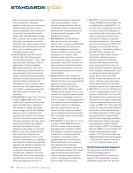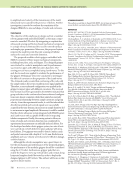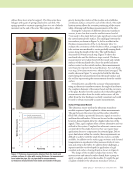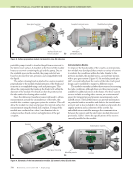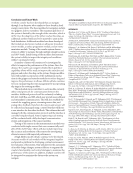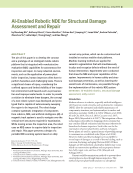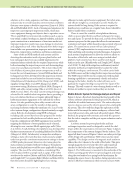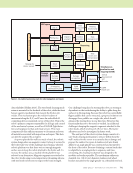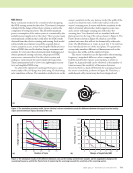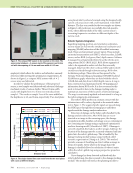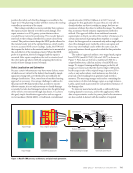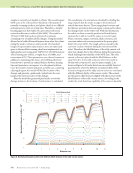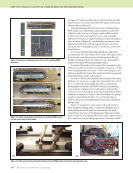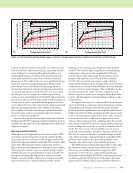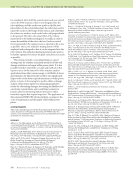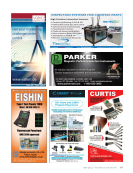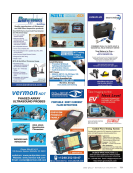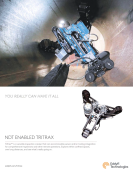724 M A T E R I A L S E V A L U A T I O N • J U L Y 2 0 2 1 Pipe Inspection by Gripper with EMATs The dynamic movement of the gripper and its electrical components may affect the performance of EMATs. To analyze this phenomenon, in this study the modular gripper integrated with EMATs was used for testing pipes. Two sets of tests were carried out on both defect-free pipes and pipes with artificial defects in a semiautomatic manner. As discussed previously in this paper, the designed gripper was attached to a robotic arm, which can be programmed to move a tool and communicate with other machines. A full laboratory setup for pitch-catch experiments using the robotic arm is shown in Figure 11. The movements of the gripper were controlled using the robot manipulator touchscreen control panel. Once initial tests were conducted on the robot and after setting up the data acquisition system, a code was created to allow the robot to move in a more autonomous way between two points to better mimic the movements of the LTI robot in action. This could be accomplished using the pick-and- place option in the robot manipulator software. This coding simplified the process because the only manual action required was to move the robot to the desired place using the robotic arm touchscreen and lock it there. Therefore, the first position was above the pipe for clearance of the gripper subsequently, the manipulator moved down, allowing the gripper to close and wait for a desired amount of time to conduct tests before it moved to a second location. Figure 11 shows one gripper grabbing the intact pipe’s surface while the EMATs on adjacent fingers communicate with each other. In fact, the robot system moved in a longitudinal direction. At the same time, EMATs inspected the defect-free pipe by transmitting and receiving Lamb waves. The grabbing process was designed with an open-loop feedback control, in which the gripper motors were controlled by a simple user-interface which would send high-level commands to actuate. An instruction packet containing the operating speed required for closing the fingers was sent to the pipe. Based on signal characteristics (shape and ampli- tude), the operator sent another instruction packet to stop the motor and ensured that the gripper latched onto the pipe correctly. After recording and collecting data from the EMATs, the operator sent an instruction packet that allowed the gripper fingers to open up. It is worth mentioning that, based on the results described in the previous section, the sensing program was carried out using a nonconformed configuration. As shown in Figure 12, according to the inspection results recorded using the gripper, directly transmitted signals and received signals were successfully acquired in the time domain. The figure illustrates that as the sample diameter ME TECHNICAL PAPER w modular robotic gripper for tubular components Data acquisition system Software Touchscreen Cylindrical magnet Spiral coil Robotic arm Gripper Figure 11. Experimental setup for EMAT testing of the gripper. 0 0 50 100 150 –2 –4 2 Time (μs) 0 0 50 100 150 –2 –4 2 Time (μs) 0 0 50 100 150 –2 –4 2 Time (μs) Figure 12. Lamb wave time histories on pipes: (a) 73.025 mm OD (b) 88.9 mm OD and (c) 114.3 mm OD. (a) (b) (c) Amplitude (V) ×104 Amplitude (V) ×104 Amplitude (V) ×104
J U L Y 2 0 2 1 • M A T E R I A L S E V A L U A T I O N 725 increased, signal amplitude increased under the same testing conditions. This increase can be attributed to the following factors: the coil-conforming mode had little effect on the generation of Lamb waves and the geometry of the gripper resulted in better functionality for current pads on pipes with a diameter of #114 mm. Another interpretation of this state- ment is demonstrated in Figure 13, which indicates that the maximum amplitude linearly decreased as the curvature of the test sample increased. As discussed in the introduction, the tubular components in power plants throughout their life suffer from defects such as corrosion, cracks, and stress corrosion cracks. In this part, the proposed modular gripper was used to detect simulated defects in a stainless steel pipe sample. To this end, two artifi- cial defects were introduced on the pipe with the OD of 88.9 mm. A surface longitudinal crack and partial corrosion with a depth of 1 ± 0.1 mm (30% of the pipe thickness) were simulated. The crack is 25 mm long and approximately 0.5 mm wide. The circular shape corrosion, on the other hand, has a diameter of 25 mm (see Figure 14). To better evaluate the performance of a pair of trans- ducers embedded in the pitch-catch configuration, two grippers were attached to the robotic arms separately to mimic the movements and performance of the LTI robot. The EMAT sensors (transmitter and receiver) were embedded on a finger of each gripper. Figure 14 shows the placement of the EMAT and the defect locations. As seen in Figure 14, the spiral coils are located on each side of the partial cracks and corrosion (all the sensors are in line with the defect in the center). The crack position was selected to be parallel to the wave propagation to simulate the worst-case scenario and have the minimum effect on wave propagation. Figure 15 shows pitch-catch signals taken when the pair of EMAT sensors is located 10 cm away from the center of the defects. In this figure, the signals in the presence of the defects are compared with the signal response of an intact pipe. A reduction in signal amplitude and velocity are clearly observed when the defect lies between the transmitter and receiver. The results show that to detect the defects using the inte- grated gripper-sensing system, one can monitor the changes 15 0.6 0.8 1 1.2 1.4 1.6 1.8 2 20 κ (1/m) 25 30 Figure 13. Relationship between signal amplitude and sample curvature. Figure 14. Experimental setup for EMAT testing of two grippers on the pipe with artificial defects: (a) partial crack (b) partial corrosion. (a) (b) Crack Corrosion 2 Time (μs) 1 0 0 50 100 150 –1 –2 No defect Crack 2 Time (μs) 1 0 0 50 100 150 –1 No defect Corrosion Figure 15. Experimental A-scan from the defect and intact areas: (a) partial crack (b) partial corrosion. (a) (b) Max amplitude (V) ×104 Amplitude (V) ×104 Amplitude (V) ×104
ASNT grants non-exclusive, non-transferable license of this material to . All rights reserved. © ASNT 2025. To report unauthorized use, contact: customersupport@asnt.org



























































